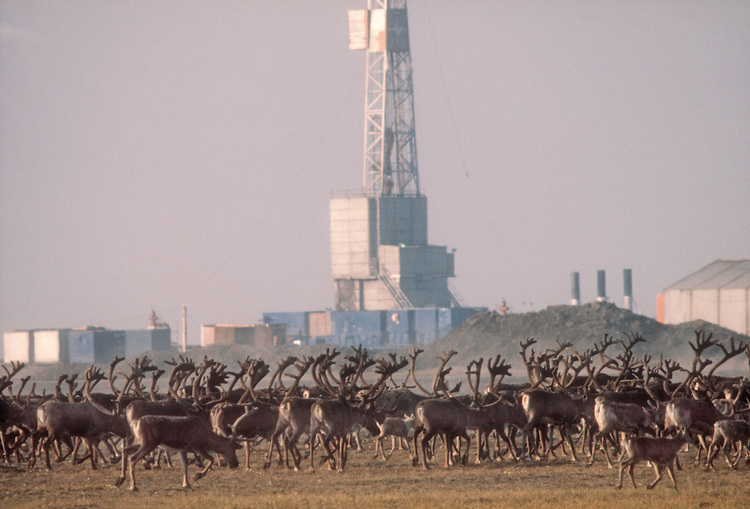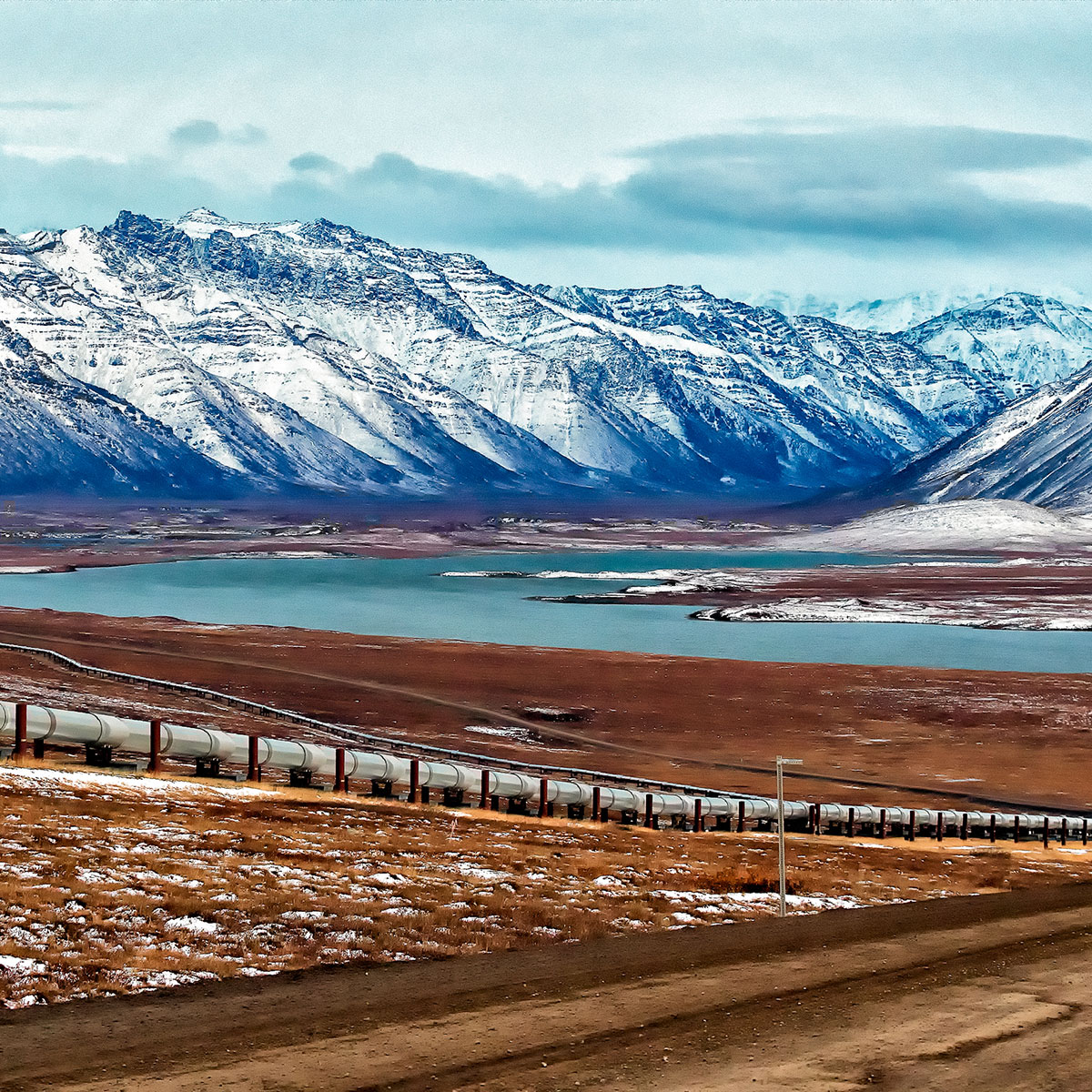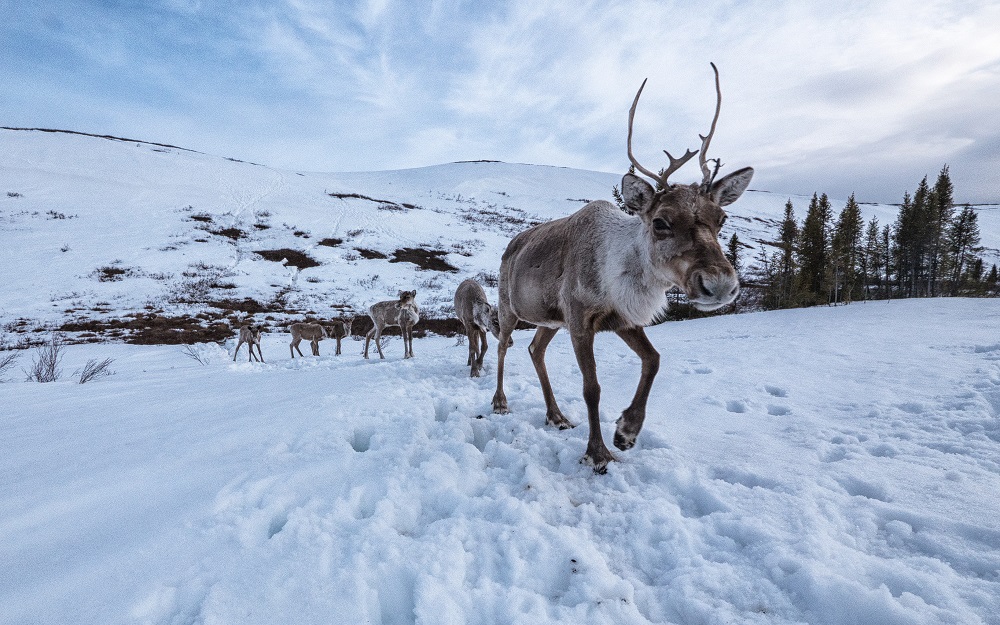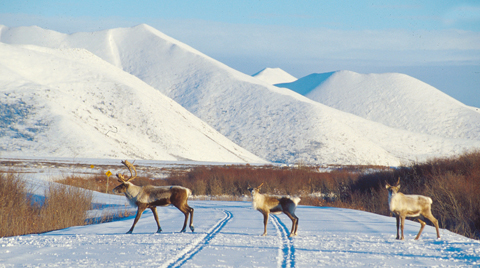
Alaska, Caribou, North Slope oil fields, Rangifer tarandus, Porcupine herd, moving past Prudhoe Bay Arctic Drilling Rig, North Slope, Alaska, 1978
The Arctic porcupine caribou has traversed the same migration path for the past 27,000 years. Surviving the last two major glaciations, the Arctic caribou once stood alongside Mastodons, Wooly Mammoths and Sabre-Tooth Tigers, but today they are being threatened (Maher, P., 2017). Chevron, British Petroleum, Arco and Exxon have begun to fight for the land the caribou have called home for decades. These companies want oil. Under the Arctic porcupine caribou, lies huge reserves of crude oil. Completely oblivious of the multi-billion dollar companies vying for the land beneath their hooves, the Arctic caribou teeters on the edge of disaster.
The Arctic National Wildlife Refuge (ANWR) established in 1960 by President Dwight D. Eisenhower, protects the Arctic’s “unique wildlife, wilderness, and recreational values” (US Fish and Wildlife Service, 2014). The ANWR expanses 19.64 million acres on the northern coastline of Alaska (National Park Service, n.d.). In 1980, this area’s future was solidified as President Jimmy Carter expanded the protection, designating much of it as “protected wilderness” under the Alaska National Interests Lands Conservation Act (ANILCA) (“A Brief History of the Arctic National Wildlife Refuge”, 2017). Protected wilderness, defined as the “wildest of the wild”, is “an area where the earth and its community of life are untrammeled by man, where man himself is a visitor who does not remain” (“Why Protect Wilderness”, n.d.). It contains no roads or other kinds of human development. It is the highest level of conservation protection offered by the federal government.
Within ANILCA, Section 1002 mandated a comprehensive assessment of natural resources on the 1.5 million acres of the refuge’s Coastal Plain. This assessment included research into fish, wildlife, petroleum, and the potential impacts of petroleum and gas drilling on the region. Because the ANWR Coastal Plain is discussed in Section 1002 of ANILCA, it is now referred to as the 1002 Area (U.S. Fish and Wildlife Service, [USFWS] 2014)
Much of what we know today about animal species in the ANWR comes from the ANILCA natural resource assessment. The ANWR is home to an array of 250 species of wildlife, including polar bears, Arctic caribou, grizzly bears, and various species of waterfowl (Alaska Wilderness League, 2017). The ANWR is the only national conservation area where polar bears regularly den and has become increasingly important as polar bear habitat is lost to climate change (Refuge Association, 2017). Birds from the ANWR migrate to every US state and territory, and can be found on 6 continents. The porcupine caribou herd, the largest caribou herd within the ANWR, returns every spring to the Coastal Plain to calve and raise their young (Refuge Association, 2017).
The ANWR porcupine caribou herd is one of the largest caribou herds in the world, with approximately 197,000 members (U.S. Fish and Wildlife Service, 2016). The ANWR is the only place on Earth that someone can find a porcupine caribou. The ANWR, home to a network of plains, waters and mountains, provides an environment unlike almost anywhere else. Its unique ecological composition makes it the perfect place for the porcupine caribou to live, raise their young and migrate throughout (“Frequently Asked Questions”, n.d.).
In the spring, the caribou leave their southern habitat and move north to the Coastal Plain of the ANWR. This is the preferred calving, or birthing, ground of the herd. Members of the herd travel anywhere from 400 to 3,000 miles to get to this area. After the caribou give birth in June, the herd remains on the Coastal Plain and forages until mid-July, allowing time for the calves to grow strong enough to journey south (Refuge Association, 2017).
The Coastal Plain is the preferred calving habitat of the porcupine herd for multiple reasons. The Plain has a small population of predators such as brown bears, wolves, and golden eagles. This gives calves a greater chance of survival in their youngest stages. The Coastal Plain also has an abundance of vegetation preferred by Arctic caribou. Vegetation thrives during the caribou calving period, providing pregnant and nursing caribou with the nutrition needed to survive the harsh conditions (Refuge Association, 2017). The ANWR Coastal Plain is the only place that the caribou could raise their young.
For thousands of years, the Gwich’in or “caribou people” of the ANWR have depended on the migrating arctic porcupine caribou for food, clothing, shelter and tools. The Gwich’in culture is so “interwoven with the life-cycle of the herd” that their survival as a people is completely dependent on the caribou (Albert, P., 1994). One fundamental Gwich’in belief is that “every caribou has a bit of the human heart in them; and every human has a bit of caribou heart.” Paul Josie, a member of one of the 13 Gwich’in villages, describes any “threat to the caribou is a threat to us… to our way of life” (Maher, P., 2017). Not only does the caribou satisfy these indigenous people’s spiritual needs, but the hunting and distribution of the caribou meat enhances their social interaction with other tribes in the area. The caribou has become a vital component of the indigenous people’s mixed subsistence-cash economy (Maher, P., 2017).
But the lives of both the porcupine caribou and the Gwich’in people are at risk. Oil development in the ANWR is threatening the migratory and birthing habits of the caribou, which in turn jeopardizes the Gwich’in way of life.

If the ANWR was to be developed for oil production, it is estimated that 303,000 acres of calving habitat, or 37% of their entire natural calving habitat would be lost to human development (US Department of the Interior, p. 120). Furthermore, studies indicate there is a direct correlation between human development and a decrease in animal habitat quality of the ANWR. In areas within 4 km of surface development, caribou use of the land declined by 52% (Nelleman & Cameron, 1996, p. 26). There is an estimated 1,000 meter disturbance zone around oil wells and a 250 meter disturbance zone around roads and seismic lines (Dyer et al., 2001, p. 531). The most consistently observed behavior in response to these petroleum developments among calving caribou is avoidance of the petroleum infrastructure (Griffith et al., 2002, p. 34). Because the ANWR is currently undeveloped, drilling development would need to be widespread and has the potential to take up huge amounts of land. Roads, barracks, storage structures, well pads, and pipelines would all have to be created. The negative impacts on the caribou from human development would be amplified and enormous.
The human development would force calving caribou to move to other, less nutrient rich grounds outside of the Coastal Plain, but this would be disastrous. Caribou calf survival has been shown to be much lower in areas outside of the Coastal Plain (Johnson et al., 2005). In the late 90’s, snow cover reduced access to the foraging grounds of the Coastal Plain, forcing the Porcupine caribou herd to nearby Canada. When this happened, the calf survival rate of the herd dropped 19% (Griffith et al., 2002, p. 34).
Whether it is a good or bad thing, oil and gas are rooted in Alaskan society; oil drilling built Alaska. Much of what we know today about oil in Alaska comes from the same ANILCA research that looked into the porcupine caribou. Seismic exploration conducted to assess petroleum resources, determined that there are approximately 10.6 billion barrels of petroleum lying beneath the ANWR (U.S. Geologic Survey [USGS], 1998). For context, Alaska’s second largest oil field, Prudhoe Bay, contains only 2.5 billion barrels. (Harball, E. 2017). If drilling were to commence today, the ANWR would contribute about 2% of the total US daily oil production by 2020. By 2030, it would account for more than 10% of the US’s daily oil production. Between the years 2018 and 2030, the US would save $202 billion on foreign oil importation (Harball, E., 2016).
The impact of oil production on Alaska has been massive. Taxation on the North Slope has generated over $50 billion for the state. 80 percent of Alaska’s revenue comes from oil production. Statewide, the oil industry accounts for a third of all jobs, and is currently Alaska’s largest non-governmental industry (Alaska Oil and Gas Association [AOGA], 2017). Oil and gas generate 38% of all Alaskan wages. Even those who do not work in the oil industry benefit from Alaskan oil production. Today, Alaska’s citizens receive anywhere from $1000 to $2000 a year from the Alaska Permanent Fund. The Alaska Permanent Fund, created to ensure “all generations of Alaskans could benefit from the riches of the state’s natural resources” has paid out $21.1 billion to Alaskan residents since 1976. Oil has fueled Alaska’s meteoric rise to prominence, even catapulting the Alaska median household income to the second highest in the country (“Oil Payout”, 2015). If there was no oil, Alaska would be crippled.
A state already facing a $3 billion budget deficit, needs oil to function. With production from the North Slope already on the decline Alaska needs more oil. Alaska needs the Arctic National Wildlife Refuge. The Trans Alaska Pipeline, built to carry crude oil from Prudhoe Bay to Valdez (the northernmost point in America free of ice), stretches 48 inches in diameter. It was built this way to accommodate the large flow volumes from Prudhoe Bay, and the Arctic National Wildlife Refuge, where drilling was expected to begin shortly. At its peak, the pipeline would push almost 2 million barrels of oil a day. Today the pipeline is far below its optimum daily flow, averaging only about 515,000 barrels a day (Brehmer, E,. 2017). Around 1990, the North Slope, which supplies the bulk of the state’s oil production, peaked. Since then, oil production has been steadily decreasing and the flow through the Alaskan pipeline has been falling by 5 percent each year (Wight, P., 2017). With oil production slowing at Prudhoe Bay, the pipeline, and Alaska’s economy is in jeopardy.
With potentially ten billion barrels of oil in the 1002 region, pro-oil politicians throughout America and throughout Alaska call for the necessity to drill. They believe more drilling is the most immediate and easiest solution to the dwindling Alaskan oil production. Lisa Murkowski, the state’s senior senator and the chair of the Energy and Natural Resources Committee responsible for America’s use of natural resources, argues that oil is what has allowed for the development and upkeep of Alaskan “schools and roads and institutions”. She argues that in order to stay relevant and “to stay warm” in the face of a dwindling oil supply, drilling needs to occur in the ANWR (Friedman, 2017).
Murkowski, hoping to work around Section 1002, advocates for using Section 1003 of ANILCA which states “production of oil and gas from the Arctic National Wildlife Refuge is prohibited and no leasing or other development leading to production of oil and gas from the [Refuge] shall be undertaken until authorized by an act of Congress” (U.S. Fish and Wildlife Service [USFWS], 2014). Section 1003 basically states that ANWR can only be opened for drilling through an act of Congress.
In June, President Donald Trump announced his intention of withdrawing from the Paris climate accord, which is an international treaty focusing on fighting global warming and climate change. While other nations take steps to combat climate change, America’s current presidential administration has committed itself to fossil fuels. Donald Trump, with hopes of lessening America’s oil dependence on foreign governments, has taken up the call to open the 1002 area. The current administration has encouraged legislation that supports domestic energy expansion and has made it clear that they would like to continue America’s tradition of reliance on fossil fuels (Liptak, K., 2017).
Senate discussions led by Senator Murkowski, lean very heavily in favor of opening up the area to drilling. A referendum on the Tax Cuts and Jobs Act that was recently passed through Senate, authorizes the sale of oil and gas leases in a section of the ANWR. Soon, energy companies will be able to search for, and extract oil and gas from the frozen tundra (Meyer, R., 2017). Murkowski and the Trump administration has made ANWR drilling an almost guaranteed occurrence. With this approval of both the President and the committee chair responsible for natural resources in America, environmentalists need to recognize the real threat.
Environmentalist’s need to shift their focus from not drilling at all, to how drilling can be done in an environmentally conscious way. A practice that has the possibility to satisfy these criteria by reducing the environmental impact of oil drilling is Extended Reach Drilling (ERD). ERD is the practice of drilling non-vertical, very long horizontal wells. Extended reach drilling is a more advanced way to extract oil and is more efficient than traditional vertical well boring. Studies show that the ERD horizontal reach extends twice as far as standard vertical drilling methods (Bennetzen et al., 2010). Whereas standard reach drilling sites can only reach 4 km horizontally, an 8 km well is now considered standard depths for ERD (Finer et al., 2013). With distances of over 8 km being the norm, drill pads can be distanced at 16 km away from each other. (“Average Depth of Crude Oil and Natural Gas Wells”, 2017) ERD wells reduce the area required to set up and drain oil reserves due to the drills extended radius. There is no need to build large amounts of drill pads to extract every oil reserve within a small area (Finer et al., 2013). Using extended reach drilling can drastically reduce the amount of land disruption caused by vertical drill wells. Habitat fragmentation, normally common around drilling sites, will be drastically reduced. Arctic caribou migration will not be affected as drastically as it would have been with standard reach drilling.
Studies from the Western Amazon have shown that half the drill pads normally used for standard reach drilling will be needed for ERD. Platforms were planned to be placed 8km away from each other, however ERD is capable of doubling that distance. All wells within a 16 km radius, were eliminated from the plan (Finer et al., 2013). The original plan consisted of 66 platforms, but 31 could be eliminated with extended reach drilling (Finer et al., 2013). Implementing ERD sites over standard platforms can save huge expanses of land from being disrupted, which directly translates to lessened environmental impacts to the ANWR.
Reducing infrastructure by using ERD sites will immediately reduce disruption of the land. Each new drilling platform requires approximately 5 to 11 acres of land, with an additional 14 acres for production phase processing stations. For example, Block 67, an area of land in the Western Amazon planned to use non-ERD sites consisting of 3 processing stations and 21 drilling platforms. This would require an environmental footprint of over 1 square kilometer. After implementing ERD sites into this scenario, 18 drilling platforms and one processing facility were eliminated, reducing land disruption by over 75% (Finer et al., 2013). ERD could preserve many acres of land for foraging caribou in the ANWR.
One concern for oil companies is the economic feasibility of using ERD platforms. Because it is a new technology, many companies are wary of its practicality. But Exxon Mobil, a leader in the world of oil production, understands it’s unique benefits. In their Russian Sakhalin-1 Project, Exxon uses ERD because they recognized the importance of the technology. To date, Exxon has drilled 43 of the world’s 50 longest-reach wells (“Extended reach technology”, n.d.). In the California OCS Santa Maria and Santa Barbara-Ventura basins, oil companies are considering using ERD to tap into 16 billion barrels of oil that lies off the California coast (California State Lands Commission [CSLC]). These oil companies would utilize ERD as an “economically and environmentally acceptable alternative” to traditional drilling sites. Fewer wells, reduced noise and air emissions, and the elimination of many new platforms incentivize these companies to use ERD. The long reach would significantly reduce the impact to the marine biology and habitats along the coast (“Oil and Gas Leases”, 2015). There would be minimal adverse effects on the environments, with most of the damage occurring in the marine survey and pre-development stage. When comparing EDR to traditional drilling, the economic benefits are enormous (Bjorklund, 2007).
With the passage of the Tax Cuts and Job Acts by the American senate and Alaska’s fossil fuel reliance, America has to prepare itself for drilling in the ANWR. America needs to understand and familiarize itself with the needs and necessities of the Arctic porcupine caribou. The caribou’s safety and livelihood must stay at the forefront of all drilling development conversations. Drilling needs to occur in the least consequential and most environmentally sustainable way possible. Extended Reach drilling is the answer. By reducing land disruption by 75%, and minimizing habitat fragmentation, ERD is the drilling practice that must be utilized to save the Arctic porcupine caribou. Alaska needs oil and the porcupine caribou need ERD.
AUTHORS
Justin Bates – Geology
Caitirn Foley – Environmental Science
Andrew Rickus – Building and Construction
REFERENCES
A brief history of the Arctic National Wildlife Refuge. (2017). Alaskawild.org. Retrieved 15 November 2017, from http://www.alaskawild.org/wp-content/uploads/2014/05/Arctic-Refuge-history-fact-sheet.1-25-17.pdf
Albert, P (April 1994). The Caribou Issue in Canadian-American Relations, Porcupine Caribou Management Board. Retrieved 1 December 2017, from http://arcticcircle.uconn.edu/ANWR/anwralbert1.html
Average Depth of Crude Oil and Natural Gas Wells. (2017). Retrieved November 28, 2017, from https://www.eia.gov/dnav/pet/pet_crd_welldep_s1_a.htm
Bennetzen, B, Fuller, J., Isevcan, E., Krepp, T., Meehan, R., Mohammed, N., . . . Sonowal, K. (2010). Extended-reach wells. Retrieved November 14, 2017, from https://www.slb.com/~/media/Files/resources/oilfield_review/ors10/aut10/01_wells.pdf
Bjorklund, T. (2007). The Case for Using Extended Reach Drilling to Develop California OCS Reserves from Onshore Locations. AAPG Database Inc., Retrieved from http://www.searchanddiscovery.com/documents/2007/07027bjorklund/
Brehmer, E., (2017). For the Alyeska team, it’s 40 years down and 40 to go. Alaska Journal of
Commerce, alaskajournal.com. Retrieved on December 1 2017, from
http://www.alaskajournal.com/2017-01-26/alyeksa-team-its-40-years-down-and-40-go#.Wh8cHrT80fF
Dyer, S., O’Neill, J., Wasel, S., & Boutin, S. 2001). Avoidance of industrial development by woodland caribou. The Journal of Wildlife Management, 65(3), 531-542. Retrieved from http://www.jstor.org/stable/3803106
Extended reach technology. ExxonMobil. Retrieved on December 2 2017, from http://corporate.exxonmobil.com/en/technology/extended-reach-technology/about/overview
Facts and Figures. (2017). Alaska Oil and Gas Association, aoga.org. Retrieved 14 November 2017, from https://www.aoga.org/facts-and-figures
Finer, M., Jenkins, C. N., & Powers, B. (2013). Potential of best practice to reduce impacts from oil and gas projects in the Amazon. PLoS ONE, 8(5), e63022. http://doi.org/10.1371/journal.pone.0063022
Friedman, L. (2017, November 1). An Alaska Senator Wants to Fight Climate Change and Drill for Oil, Too. Retrieved from https://www.nytimes.com/2017/11/01/climate/murkowski-alaska-anwr.html?_r=1
Frequently asked questions. Wilderness.nps.gov. Retrieved 15 November 2017, from https://wilderness.nps.gov/faqnew.cfm
Griffith, B., Douglas, D.C., Walsh, N.E., Young, D.D., McCabe, T.R., Russel, D.E.,…Whitten, K.R. (2002). The Porcupine caribou herd. U.S. Geological Survey, Biological Resources Division, Biological Science Report USGS/BRD/BSR-2002-0001.
Harball, E (2017). Alaska’s 40 Years Of Oil Riches Almost Never Was. npr.org. Retrieved on November 29 2017, from https://www.npr.org/2017/06/24/533798430/alaskas-40-years-of-oil-riches-almost-never-was
Harball, E., (2016). How much oil is really in ANWR?. alaskapublic.org. Retrieved on November 30, 2017, from https://www.alaskapublic.org/2016/12/07/how-much-oil-is-really-in-anwr/
Johnson, C., Boyce, M., Case, R., Cluff, H., Gau, R., Gunn, A., & Mulders, R. (2005). Cumulative effects of human developments on Arctic wildlife. Wildlife Monographs, (160), 1-36. Retrieved from http://www.jstor.org/stable/3830812
Liptak,K., (2017). WH: US staying out of climate accord. CNNpolitics, Retrieved on December 1 2017, fromhttp://www.cnn.com/2017/09/16/politics/trump-paris-climate-deal/index.html
Nellemann, C., & Cameron, R. (1996). Effects of petroleum development on terrain preferences of calving caribou. Arctic,49(1), 23-28. Retrieved from http://www.jstor.org/stable/40511982
Management of the 1002 Area within the Arctic Refuge Coastal Plain – Arctic – U.S. Fish and Wildlife Service. (2014). Fws.gov. Retrieved 15 November 2017, from https://www.fws.gov/refuge/arctic/1002man.html
Meyer, R., (2017). The GOP Tax Bill Could Forever Alter Alaska’s Indigenous Tribes. The Atlantic, theatlantic.com. Retrieved on December 2 2017, from https://www.theatlantic.com/science/archive/2017/12/senate-tax-bill-indigenous-communities/547352/
Oil and Gas Leases. (2015). California State Lands Commission, slc.ca.gov. Retrieved 15 November 2017, from http://www.slc.ca.gov/Info/Oil_Gas.html
Oil Payout: Alaskans find out how much they get (2015). Cbsnews.com. Retrieved on December 1 2017, from https://www.cbsnews.com/news/alaskans-eager-to-learn-amount-of-upcoming-oil-payout/
Maher, P (June 2017). Alaska’s Porcupine Caribou Herd – and the People it Helps Sustain. Retrieved on December 1 2017, from https://www.newsdeeply.com/arctic/articles/2017/06/09/alaskas-porcupine-caribou-herd-and-the-people-it-helps-sustain
US Department of the Interior (1987). Arctic National Wildlife Refuge, Alaska, Coastal Plain Resource Assessment. pubs.usgs.gov, pg 120. Retrieved from https://pubs.usgs.gov/fedgov/70039559/report.pdf
Why Protect Wilderness | Wilderness.org. Wilderness.org. Retrieved 15 November 2017, from http://wilderness.org/article/why-protect-wilderness
Wight, P., (2017). How the Alaska Pipeline Is fueling the push to drill in the Arctic Refuge. Yale Environment 360, e360.yale.edu. Retrieved on December 2 2017, from http://e360.yale.edu/features/trans-alaska-pipeline-is-fueling-the-push-to-drill-arctic-refuge
*The arguments/opinions expressed in this entry do not necessarily reflect the opinions/align with the author(s) own views.
bocoran slot online
rtp slot pragmatic
info rtp slot
live rtp slot
buzdolabı servisi
Thank you so much.
Antetli Kağıt
Tanks for Article
Tanks For Sharing Information, Good Job
nice Information
It‘s the biggest shame for humans to look into the eye of the hurricane and still not want to see what is going on. Do you republicans and other rightists and super capitalists really want to eat your money? You only got a few years to live and you still dare to decide over most precious natural areas for current and future generations. Leave ANWR alone!